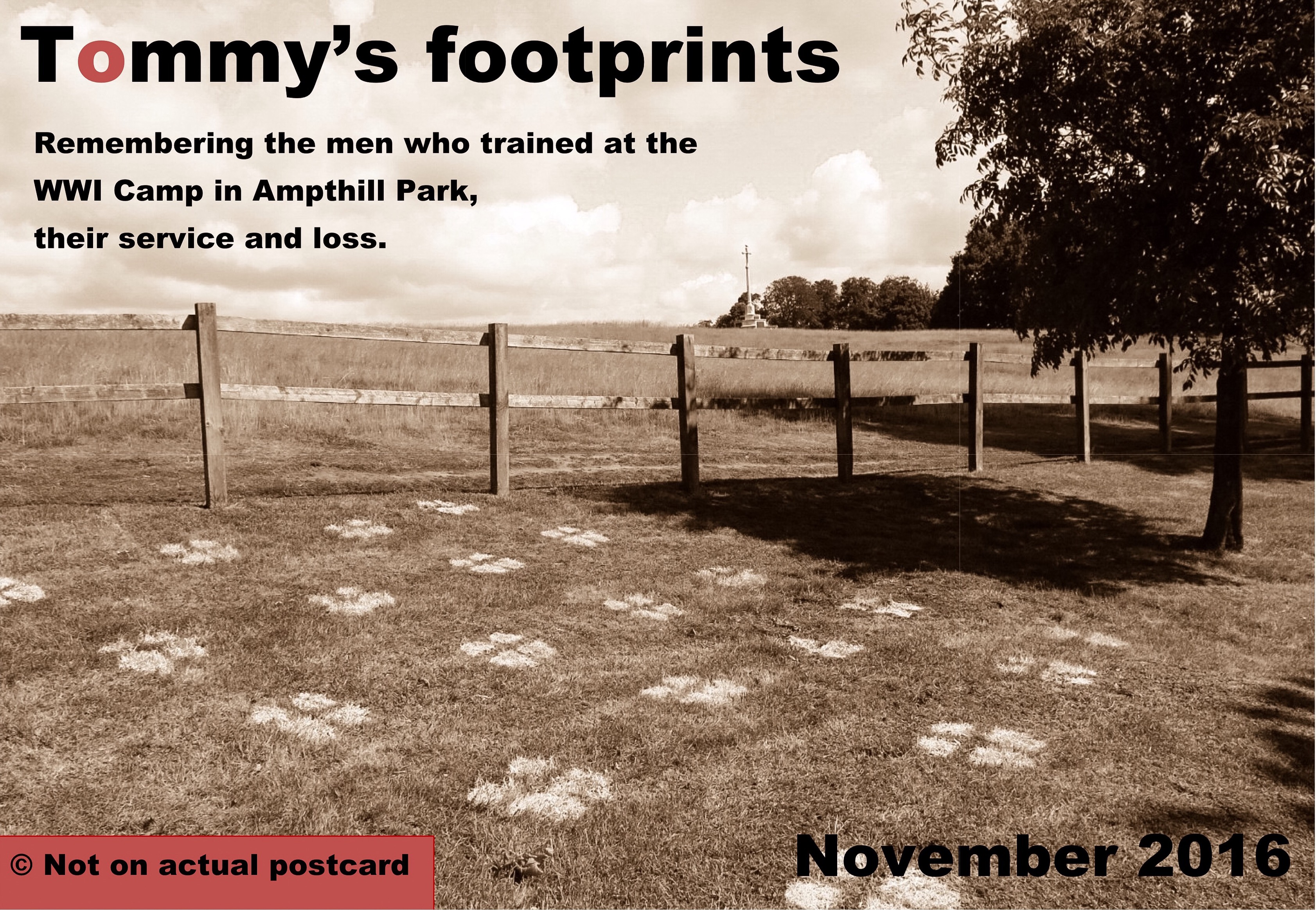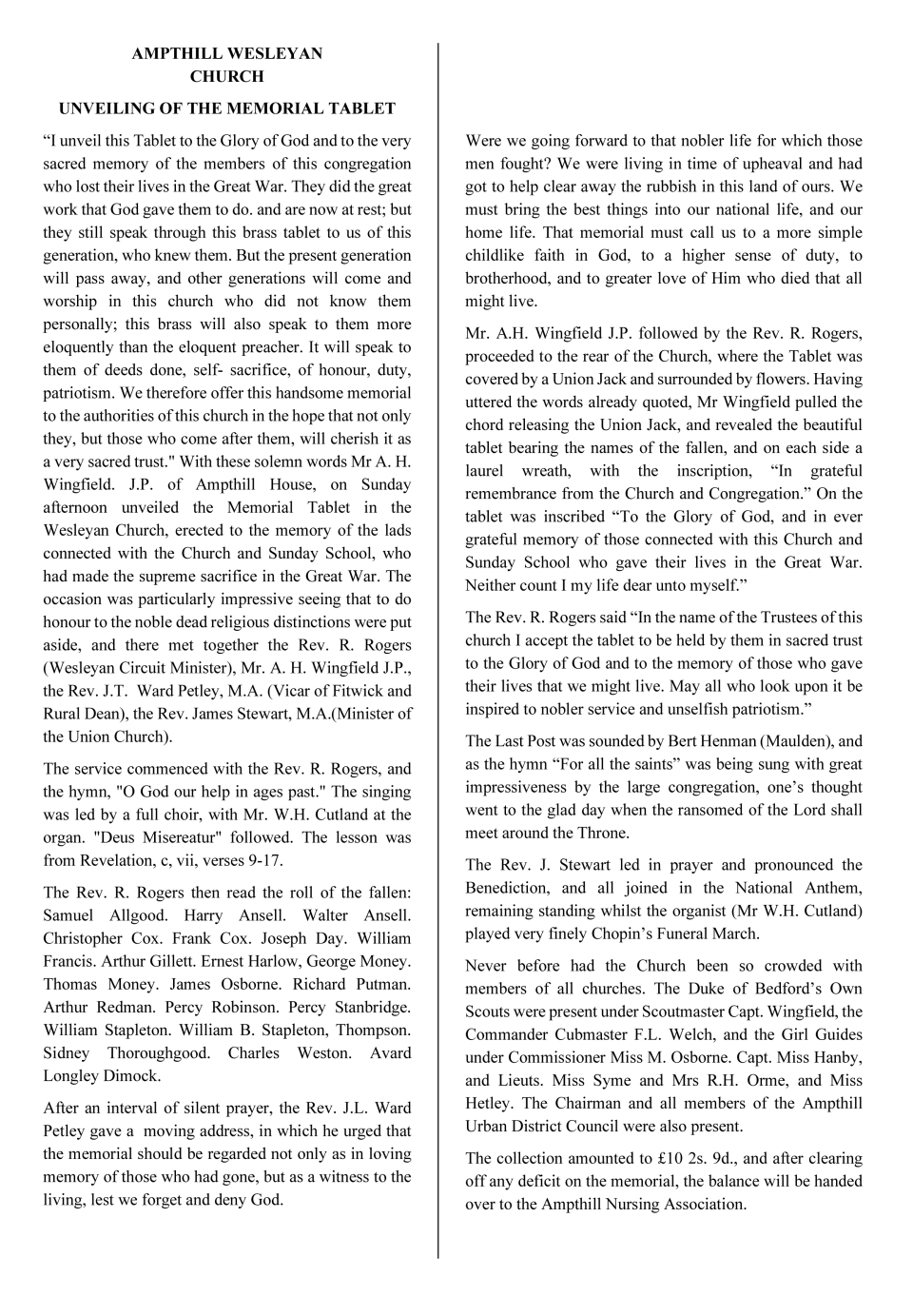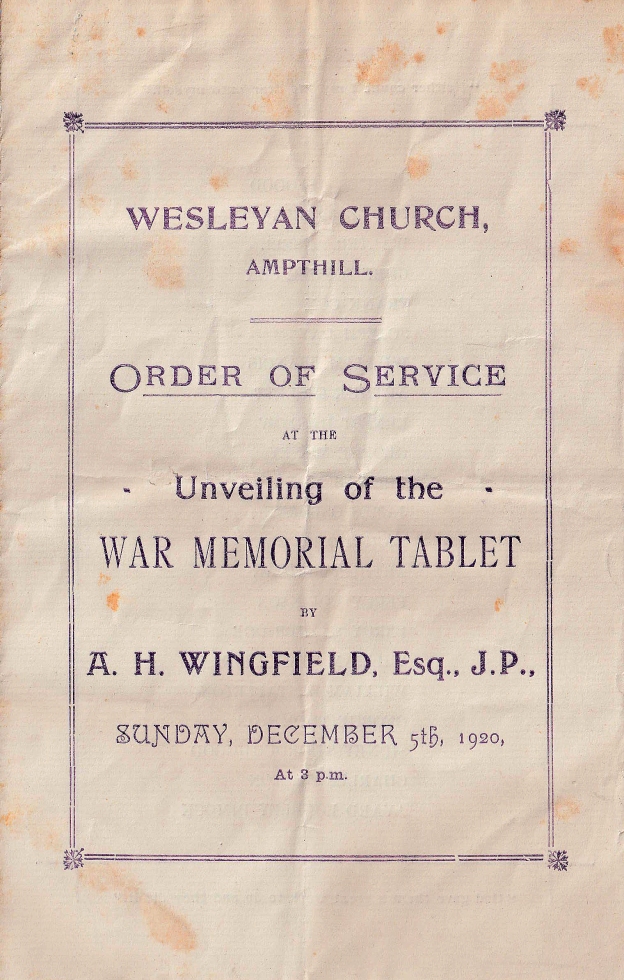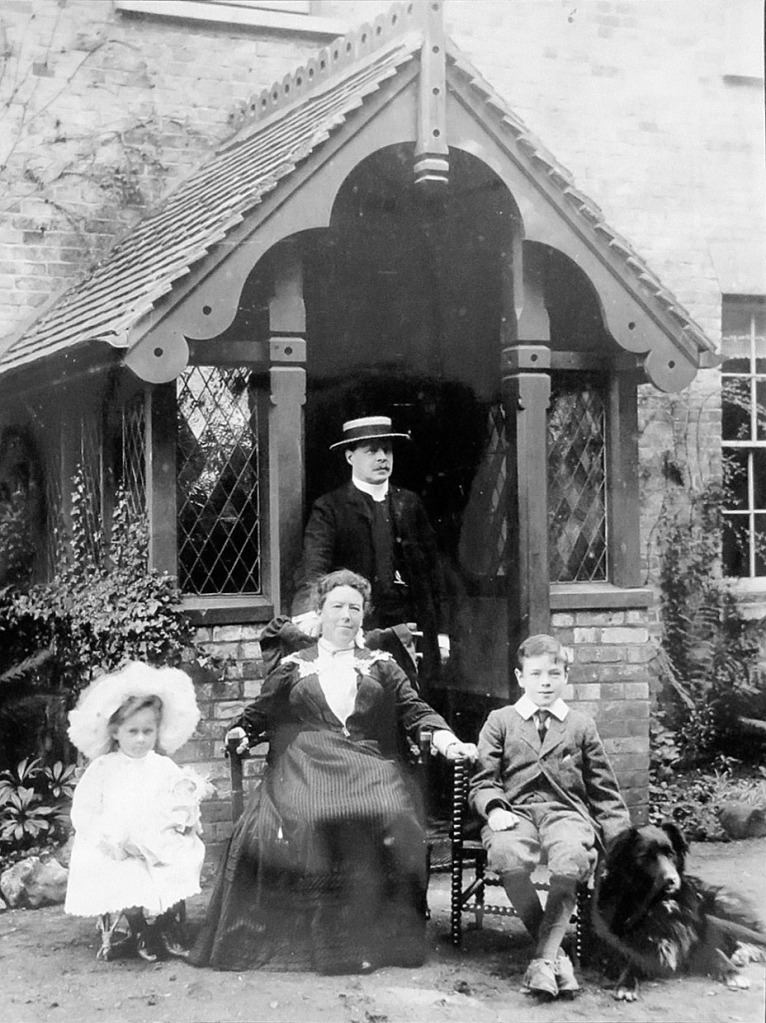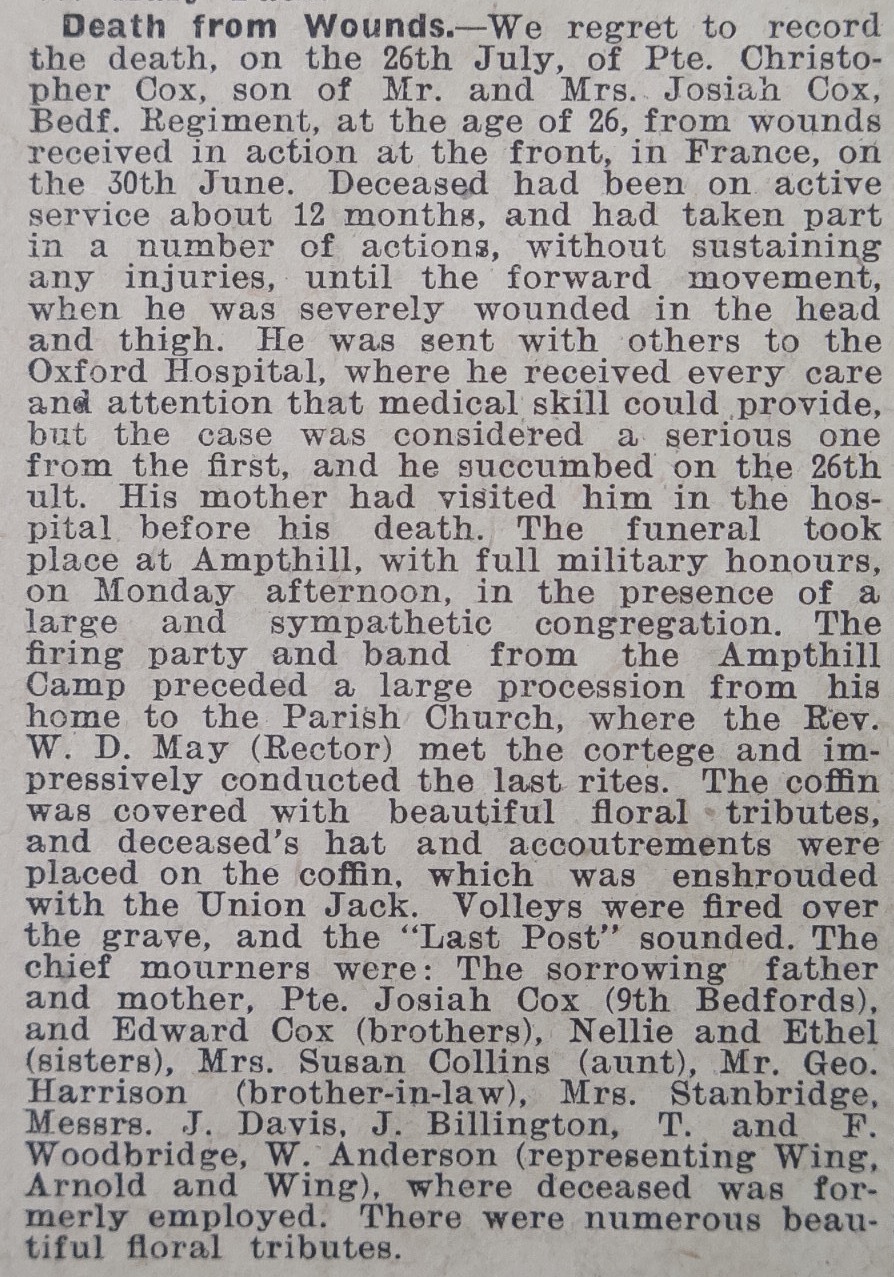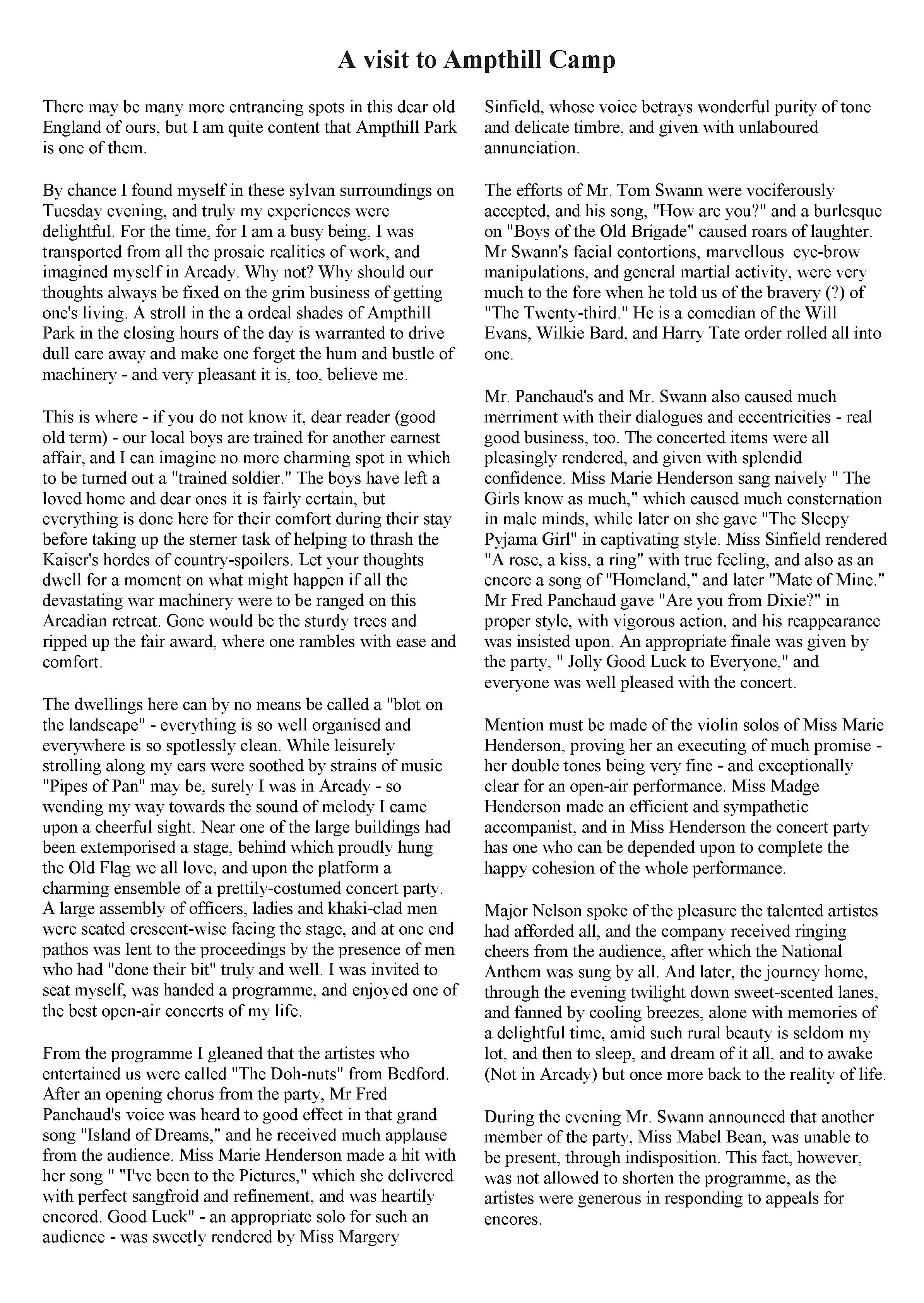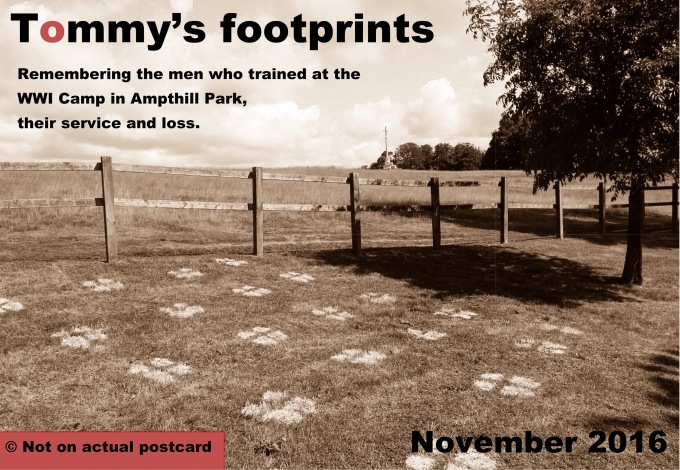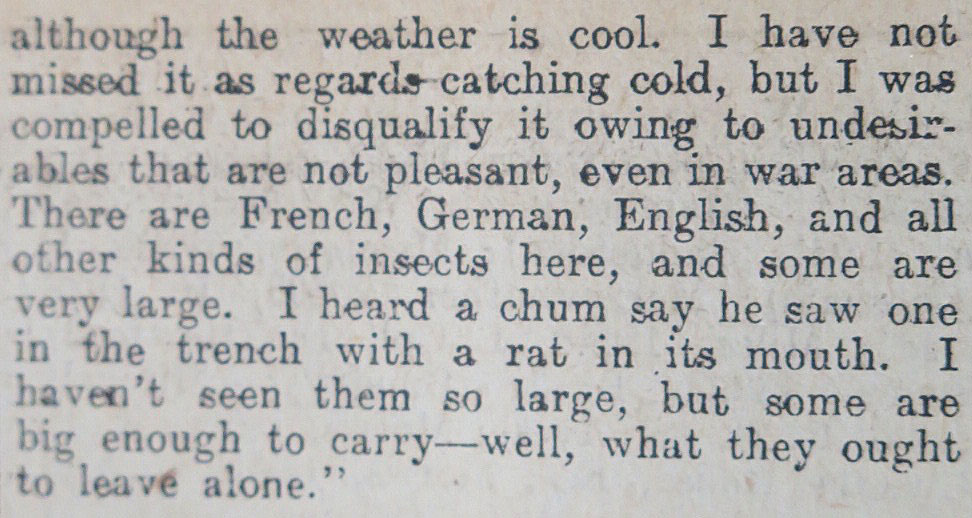The ‘Camp Diary’ provides an insight into the Bedfordshire Training Depot from 1914-16. Based on newspaper reports of the time.
September 1916 – Another draft of men have left the Camp to join the British Expedition Force. The Ampthill Camp is starting to feel decidedly empty.
On Thursday, 7th September Major-General Pilcher made an inspection of the camp and watched the cadets go through physical drill and bayonet practice. A number of men back from France, following wounds or illness, are engaged in light duties. This includes agricultural work in fields near the Camp.
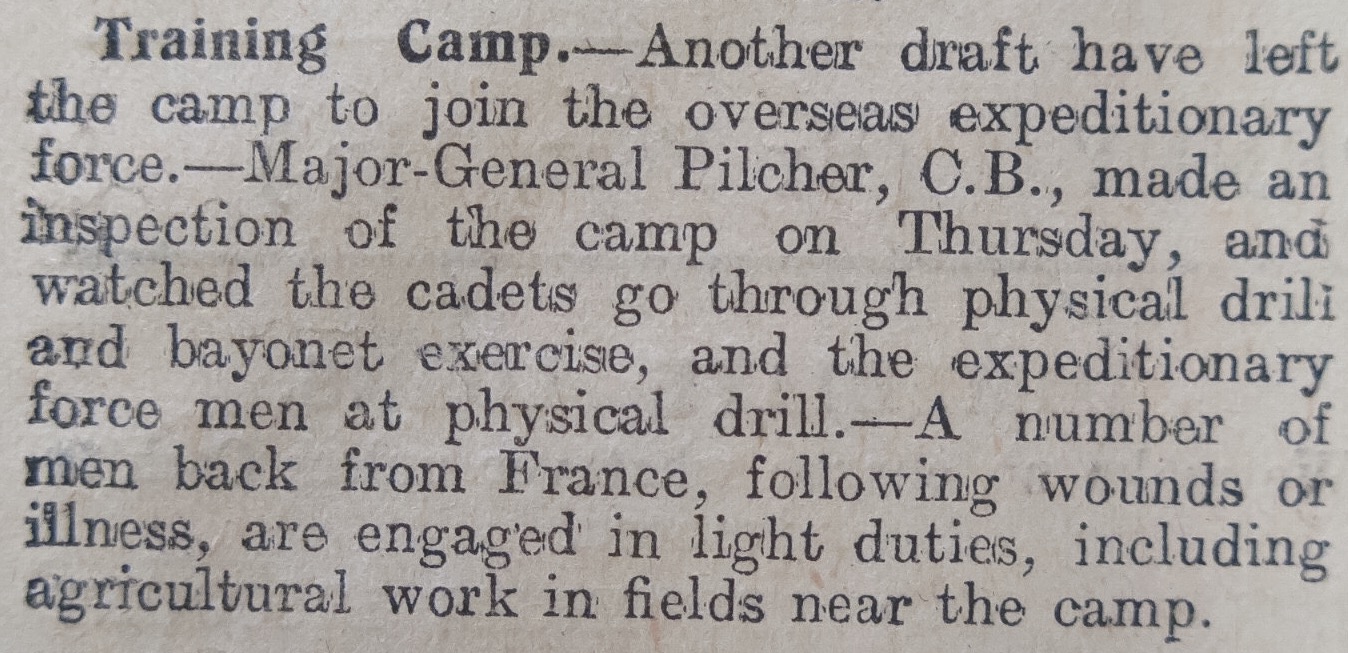
September 8, 1916

September 15, 1916
Wrest Park Military Hospital
Since the outbreak of war Wrest Park has played a major part in treating the wounded. On Thursday, 14th a convoy train of wounded soldiers were met at Ampthill Station and conveyed to Woburn and Wrest Park Hospitals. Later that day a major fire developed in the East Wing of Wrest Park. Some 160 soldiers were there convalescing at the time. Twice during the night the Ampthill Camp bugle sounded ‘parade at the double.’ The first order of the evening was for all men who had cycles or other ways of getting to Wrest Park quickly, to start off and assist with the fire. The second call came nearer midnight for the men to assist with arrangements for making comfortable about 50 wounded soldiers removed from Wrest House to Woburn Abbey Hospital and to empty huts in the Camp. The recruits also helped with salvaging valuable furniture and paintings.
This slideshow requires JavaScript.
The House survived the fire but some parts were gutted. The damage is estimated at £20,000. Thankfully there was no loss of life – read the full newspaper report.
By converting this fine country house into a hospital for wounded soldiers and practically maintaining it for two years at great personal expense, Lord Lucas has rendered great national service, and during the whole time his sister, the Hon. Miss Herbert, devoted herself with loving care and attention to the work of the hospital as Matron. Very few people, indeed, are aware of the great work that has been done at Wrest House, for our wounded heroes brought home from the battlefields.
The authorities have come to the decision that Wrest Park will no longer be used as a military hospital.
Ampthill Camp – more departures
On Friday, 22nd a small group of N.C.O.’s left the camp to join another battalion. Captain Tanqueray who has been heavily engaged with Cadet training, has rejoined the Royal West Sussex Regiment. The following officers have proceeded to France to join the Bedfordshire Regiment: Lieutenants Millars and Blanchard, and 2nd Lieutenants Matson, Sharpen, G.C. Scott, Forbes, Stanton, Piercey, Deacon, Hyde, Hope, Woodford, Hickman, Fletcher, Kingdom, and Booth.

September 22, 1916

September 29, 1916
News of Ampthill Park recruits at the Front
News has been received of two promising Maulden lads, and flags were flown at half mast.
17743 Private Charles Newman has been missing since the Battle of Loo in September last. The War Office has written to his mother intimating that sadly, death must be assumed.
Mr. and Mrs. Northwood have been notified that on September 3rd their only son, Charles, was killed in an attack on the German trenches. Lieutenant D’Airgdor writes that 17843 Private Newman was “hit by a shell.” There is news that on July 19th a similar fate befell 22523 Private William J.Shambrook of Ware who was with the 54th Mortar Battery.

Four hundred and six Bedfords’ have been killed during September. Sixty-two of these men trained at the Ampthill – the Camp’s worst month by a country mile. Most of the Ampthill men were killed in the actions of 15th and 25th September.
September 15th – The Battle of Flers-Courcelette
A grim day for the Bedfords’ – the men were part of the British attack at The Battle of Flers-Courcelette in the Somme region. The 8th Battalion had three waves of infantry in position ready to attack from shell holes. At 06:00 artillery started to lay down a heavy barrage – however, the munitions fell short causing many British casualties. At ZERO Hour [06:20] the companies pushed forwards with support. Depleted in number, the Bedfords’ failed to take their objective. Survivors returned to hold the original trenches and were then relieved.
One hundred and twenty-four Bedfords’ were killed in the action that day. Thirty-nine of these soldiers trained at the Ampthill Camp.
Casualties – September 15
22674 Private Horace AMBRIDGE (27) of Barton Killed in Action
22673 Private Albert ASHBY of Barton Killed in Action
17774 Private John ATKINSON (43) of Barford Killed in Action
22269 Private Daniel AUSTIN of Harrowden Killed in Action
20779 Private Horace BATCHELOR (27) of Flamsted Killed in Action
20527 Private Ernest BODSWORTH (25) of Woburn Killed in Action
20619 Private Archibald BONESS of Biggleswade Killed in Action
20896 Private Albert Edward BRIDGES of Hitchin Killed in Action
23247 Private William Charles BUCKINGHAM of Toddington Killed in Action
22917 Private William CAMFIELD (22) of Walsworth Killed in Action
19895 Private Fredrick COOK (22) of Tilbrook Killed in Action
20910 Private William Arthur Leonard DEVEREAUX (24) of Campton Killed in Action
18801 Private James Charles FEARY (39) of St. Ives Killed in Action
18485 Private Arthur Henry FOSTER (44) of Godmanchester Killed in Action
20667 Private William GILKS of Woburn Killed in Action
23599 Private William GODFREY (21) of Hexton Killed in Action
20969 Private William HAILEY (35) of Walsworth Killed in Action
20483 Private Herbert HARE of Old Warden Killed in Action
19546 Private Walter HENMAN of Breachwood Green Killed in Action
20397 Private Edward HORSLER (33) of Streatley Killed in Action
20941 Private Frank IRONS (18) of Wilstead Killed in Action
19498 Private George JACKSON (42) of Dunton Killed in Action
22457 Private William JACKSON (26) of Stevenage Killed in Action
20744 Private Arthur JANES (31) of Hemel Hempstead Missing (presumed dead)
20345 Private John JELLIS (33) of Upper Sundon Killed in Action
20316 Private Richard John LISTER (32) of Needingworth Killed in Action
22504 Private Robert LOVETT (20) of Biggleswade Killed in Action
23270 Private George MARTIN of Barton Killed in Action
20339 Private Alfred C. MILLWARD (40) of Olney Killed in Action
18128 Private Fredrerick PAXTON of Woburn Sands Killed in Action
22395 Private Christopher PERRY (47) of Luton Killed in Action
22746 Private Cyril Albert Bernard PINNOCK (20) of Bedford Killed in Action
20599 Private George Benjamin POULTER (18) of Killed in Action
20298 Private Henry J RANDALL (40) of Marston Church End Killed in Action
22435 Private Ernest William STEVENS (29) of Flamstead Killed in Action
22080 Private Frederick TAYLOR (34) of Hemel Hempstead Killed in Action
22850 Private Herbert WHITTINGTON (21) of Marston Shelton Killed in Action
23234 Private Charles Henry WILSON (23) of Earith Killed in Action
19593 Lance Corporal Thomas YOUNG of Kempston Killed in Action
Read the war diary for September 15, 1916: http://www.bedfordregiment.org.uk/8thbn/8thbtn1916diary.html
September 25th – The Battle of Morval
The Bedfords’ took part in an attack on German lines between Morval and Les Boeuff. The attack commenced at 12.35.p.m. and the 8th Battalion moved up to original front line when second objective had been taken about 2.35 p.m. Casualties from the enemy barrage very slight. The British attack succeded and many prisoners were taken. At night the 8th Bedfords’ furnished carrying parties to resupply the front line battalion with ammunition and water. C Platoon were detached to 1st London Company of the Royal Engineers as a working party in captured German trenches. C Company suffered very heavily from enemy shell fire.
Casualties – September 25
22594 Private Frederick CHANCE of Toddington Killed in Action
20403 Private William CHATER (22) of Olney Killed in Action
20554 Lance Corporal Arthur HANCOCK (38) of Melchbourne Killed in Action
18874 Lance Corporal Joseph LAW (21) of Sharnbrook Killed in Action
22807 Private Arthur William ODELL (24) of Marston Shelton Killed in Action
Read the war diary for September 25, 1916: http://www.bedfordregiment.org.uk/8thbn/8thbtn1916diary.html
Other September Casualties
September 3
17834 Private Charles William NORTHWOOD (21) of Maulden Killed in Action
23256 Private Harry PAGE (23) of Woburn Sands Died of Wounds
18462 Private William WARNER of Biggleswade Died of Wounds
September 4
19846 Private George William HARRIS (28) of Wootton Killed in Action
26270 Private Harold George SAWFORD (23) of Sharnbrook Died of Wounds
20059 Sergeant Walter Frederick SURRIDGE (28) of Bedford Killed in Action
September 5
18957 Private Albert Lewis CATLIN (32) of Stevenage Killed in Action
20704 Private Ernest CLARIDGE (26) of Hemel Hempstead Killed in Action
20890 Lance Corporal Reginald MANNING (24) of Toseland Killed in Action
September 6
18206 Private Walter Henry COX (27) of Renhold Died of Wounds
September 18
12101 Private Walter ASHWELL (29) of Moggerhanger Died – formerly 27646 Bedfords’
September 22
20266 Private William COOPER (21) of Luton Died of Wounds
20373 Private George CRANFIELD (29) of Flitwick Killed in Action on September 22
September 25
29460 Private Harry FINDING (19) of Raunds Killed in Action
29452 Private Christopher Francis SMITH (35) of Ridgmont Killed in Action
19220 Private Walter THOMAS (25) of Wellington Killed in Action
September 26
19477 Private Arthur GILLETT (32) of Flitwick Killed in Action
September 27
22810 Lance Corporal Charles William CANHAM (21) of Kettering Killed in Action
September 28
20817 Private Edward HILL of Barton Died of Wounds
Sources:
The Bedfordshire Standard. The original broadsheet is part of the Bedfordshire & Luton Archive.
Commonwealth War Graves Commission
RBL Roll of Honour
Bedsatwar blog
Bedsathome blog
Bedfordshire Regiment
A history of Silsoe (Roger Bradshaw, 2011
English Heritage
Next instalment to be published on 31 October 2016….
Text copyright S.Hartley (2015-)
Care is taken to ensure accuracy – please accept my apologies if the content contains any errors.
BUY: Ampthill Camp WWI Centenary Postcard
This special postcard commemorates the centenary of the WWI Bedfordshire Training Depot (1914-16). Limited edition: 500
Proceeds will help to fund a book about the Ampthill Camp ~ profits to benefit the charity Combat Stress which was founded in 1919 to help WWI veterans deal with shell shock.
£2 (inc p&p). Please email hartleyhare135@gmail.com to order by PayPal or BACS transfer.
